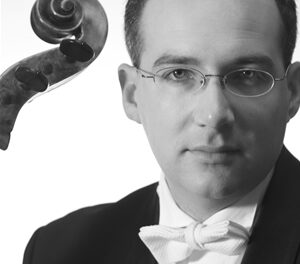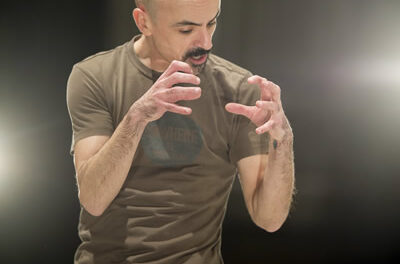 Last week’s Raleigh concert by the Attaca String Quartet featured a work by N.C. native (and Pulitzer Prize winner) Caroline Shaw. Last night’s concert in Winston-Salem by the Borromeo Quartet also featured a strong NC connection – first violinist Nicholas Kitchen who was born in Durham. He has brought his critically-acclaimed quartet to Durham many times to play on the concert series at St. Stephen’s Episcopal Church. This concert was presented under the auspices of the University of North Carolina School of the Arts.
Last week’s Raleigh concert by the Attaca String Quartet featured a work by N.C. native (and Pulitzer Prize winner) Caroline Shaw. Last night’s concert in Winston-Salem by the Borromeo Quartet also featured a strong NC connection – first violinist Nicholas Kitchen who was born in Durham. He has brought his critically-acclaimed quartet to Durham many times to play on the concert series at St. Stephen’s Episcopal Church. This concert was presented under the auspices of the University of North Carolina School of the Arts.
The program comprised three major quartets: Beethoven’s 2nd (G) and 15th (A minor), and Bartók’s 4th. The early (Op. 18/2) Beethoven work opened the concert, followed by the Bartók. After an intermission (during which we heard just how carefully the musicians tune their instruments, as the backstage sound was clearly audible) came the monumental late (Op. 132) Beethoven work.
Beethoven’s quartets are part of the Borromeo’s DNA. Not only do they perform the entire 16-quartet cycle plus the Grosse Fuge, but Kitchen has also found deeper insights into performing these works by an intensive study of the original manuscripts. He has found that Beethoven used more variations in notation than appear in the published scores; these variations give more guidance to the performers about exactly how the composer intended for the quartets to be played.
In his early (1800) Opus 18 quartets, Beethoven shows his debt to Mozart and Haydn, grounding his musical forms and language with that Viennese Classical model. Nevertheless, his “visionary” gene was already showing itself with abrupt and unexpected changes of key and formal explorations such as writing not the usual “Menuet and Trio,” but instead a “Scherzo Allegro and Trio” as the third movement of the 2nd quartet. All this was captured in the Borromeo’s collective precision and vivacious reveling in communicating the delights of this openly light-hearted music. The first quartet to perform from full-score manuscripts shown on pedal-controlled computer screens on their music stands, they were able to see the notes exactly as Beethoven wrote them, unfiltered by any exigencies of musical engraving. If there were momentary subtle differences in a phrase or a note-length, they were likely due to having to replace the Borromeo’s regular violist, Mai Motobuchi, who is recovering from an injury. The viola scores were taken over by no less of a virtuoso performer, Nicholas Cords, the violist of Brooklyn Rider. And rounding out the foursome was Kitchen’s other half, cellist Yeesun Kim, who married him in Durham, making for yet another N.C. connection.
The opening Allegro of Bela Bartók’s 4th Quartet (composed in 1928) is the tonal antithesis of the sunny G-major tonality which pervades Beethoven’s early quartet. It is violently dissonant, with its parallel seconds intensified by being syncopatedly accented. (It’s interesting to wonder what Beethoven would have thought of it.) Bartók directs portions to be played marcatissimo as well as with fire (con brio). As difficult as it is to play, it is also difficult to read; in just a single measure chosen at random, I count 36 notes, of which 22 require accidentals (#, ♭, ♮). Indeed, the only apparent consonance in the entire movement is its last note, a unison eighth-note C. Fortunately, while not to suggest that the other four movements don’t contain multiple dissonances, they occur within a palette of string colors which fall less heavily on the ear.
The 2nd through 5th movements require the ultimate in virtuosity from the musicians: bowed and plucked glissandi and cross-rhythms (2 against 3) in the 2nd-movement Prestissimo con sordino; playing without vibrato, multiple harmonics, and mutes on/off in the Non troppo lento 3rd movement; plucking the strings close to the bridge (sul ponticello), normally, and strongly (snapping the string against the fingerboard) in the 4th movement, Allegro pizzicato, which includes some of the work’s most quiet (ppp) moments; and the concluding Allegro Molto movement with some of its passages requiring the strings to be played with the wood of the bow (col legno) rather than the hair. Borromeo Quartet’s collective virtuosity was more than equal to the task at hand; their performance was all that Bartók could have wished.
While the fabled violin-makers of Kitchen’s Guarnerius and 2nd violinist Kristopher Tong‘s Stradivarius might have listened in awe to this panoply of sounds being issued from their instruments, it might have been fascinating for them to hear how composers use their imaginations to fashion new music from old cloth (the earliest score to call for col legno bowing dates from c.105). For the Borromeo to follow this music with Beethoven’s Op. 132, in which he himself explores new musical language, was a brilliant programmatic idea.
The 1825 Quartet No.15 is often referred to as the Heiliger Dankgesang quartet, from the manuscript’s 3rd movement inscription (“Heiliger Dankgesang eines Genesenen an die Gottheit, in der lydischen Tonart” / “Holy song of thanks by a convalescent to the Deity, in the Lydian mode.”) The very slow beginning of that movement gives way to a faster tempo, where Beethoven marks the score Neue Kraft fühlend (“Feeling new strength”).
When he composed this work, Beethoven was totally deaf, and recently recovered from a severe illness which he thought he might not survive. He heard only what his genius created inside his brain, which he translated into musical notation so that others could hear it. It surpasses in length by some eight pages of full score the Opus 18/2 quartet which opened this program.
From the opening pianissimo four-note figure (which is aurally reminiscent, even though different in its pitches, of the famous B-A-C-H sequence) to the concluding fortissimo of the Allegro appassionato final movement, we heard a magisterial performance. The heilige Dankgesang‘s Molto adagio / sotto voce score directions were followed to perfection as the chorale with its fugal interludes was simply exquisite. Much has been written about this music, what it meant to Beethoven and what it has meant to those who play it and those who hear it. The Borromeo’s mastery proved once again that they belong among the great string quartets of our time. If there is a benefit derived from pandemic restrictions on audience size, it is that concerts like this may be streamed online so that far more people may hear them than could be assembled in any concert hall.
Bravo, Borromeo!












